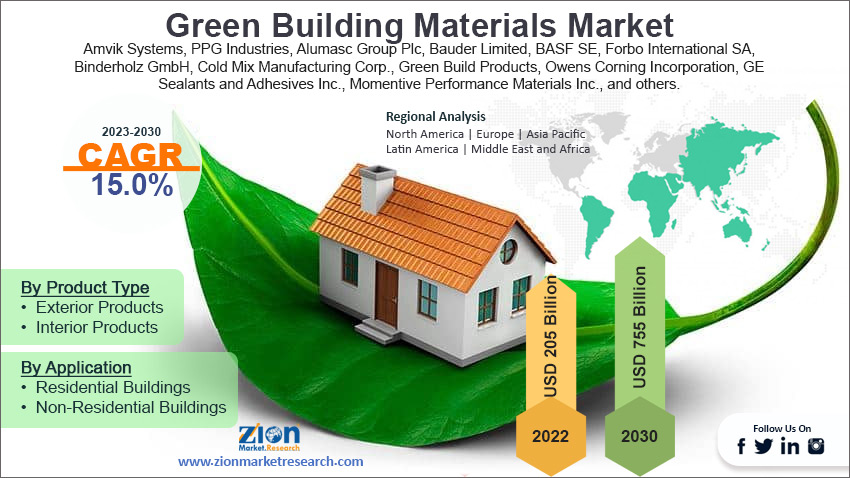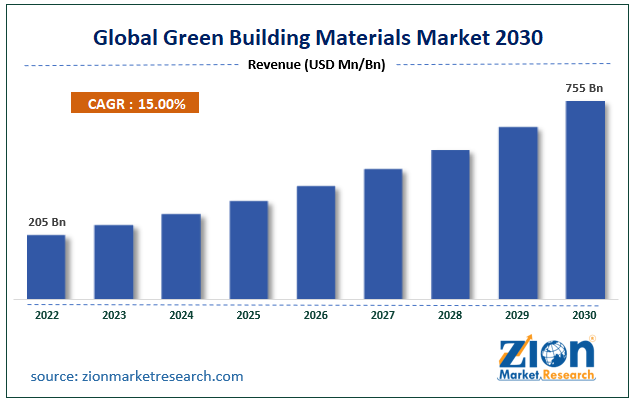Green Building Materials Market Size, Share, Growth, Trends, and Forecast 2030

Green Building Materials Market By Product Type (Exterior Products and Interior Products), By Application (Residential Buildings and Non-Residential Buildings), and By Region - Global and Regional Industry Overview, Market Intelligence, Comprehensive Analysis, Historical Data, and Forecasts 2023 - 2030-
| Market Size in 2022 | Market Forecast in 2030 | Growth Rate (in %) | Base Year |
|---|---|---|---|
| USD 205 Billion | USD 755 Billion | CAGR at 15% | 2022 |
Green Building Materials Industry Prospective:
The global green building materials market size was evaluated at $205 billion in 2022 and is slated to hit $755 billion by the end of 2030 with a CAGR of nearly 15% between 2023 and 2030.
Green Building Materials Market: Overview
Green building materials are made up of renewable, instead of non-renewable resources. Renewable building materials are products such as lumber from forests, recyclable material also includes bamboo and straw, recycled stone, dimension stone, and metals that are recyclable. These materials are also easy to maintain and consume less water in comparison to other building materials. They enable products such as bamboo to withstand wetting. It can also be refurnished easily to eradicate traces of wear and tear with a minimum cost as compared to other building materials.
Key Insights
- As per the analysis shared by our research analyst, the global green building materials market is projected to expand annually at the annual growth rate of around 15% over the forecast timespan (2023-2030)
- In terms of revenue, the global green building materials market size was evaluated at nearly $205 billion in 2022 and is expected to reach $755 billion by 2030.
- The global green building materials market is anticipated to grow rapidly over the forecast timeline owing to rising prices of fuel along with the seeking for technically superior automobiles by consumers
- In terms of product type, the exterior products segment is anticipated to register the highest CAGR over the forecast period.
- Based on application, the residential buildings segment is expected to lead the segmental growth over the period from 2023 to 2030
- Region-wise, the Asia-Pacific green building materials industry is projected to register the fastest CAGR during the assessment timespan.
 Request Free Sample
Request Free Sample
Green Building Materials Market: Growth Factors
Surging concerns over environmental degradation can prop up the global market expansion by 2030
Rising prices of fuel along with the seeking for technically superior automobiles by consumers are anticipated to support global green building materials market demand. The green building material helps in reducing carbon footprint and thus enables in reduction of the impact of global warming, thereby driving the global market trends. Due to its numerous environmental and monetary benefits, the demand is anticipated to propel market growth across the globe in the long run. The construction sector is anticipated to utilize green building materials owing to their cost-saving feature, and energy-efficient and environmental-friendly structures.
The surging cost of energy and high-performance green building products are considered to bolster the global market growth. New product launches are predicted to make an immense contribution to the global market revenue in the forthcoming years. For instance, in the second half of 2020, Lhoist, a UK-based firm manufacturing lime-based green products, introduced Tradical Hemcrete, which is a green building material. For the record, the new product can be utilized for constructing walls along with refurbishing old structures by acting as an insulation substance.
Green Building Materials Market: Restraints
Rise in the product costs & their low availability can impede the global industry trends
Growing cost concerns and barriers related to green building materials and uneven enforcement of energy regulation and along with highly price-sensitive consumers might hinder the global green building materials industry surge.
Green Building Materials Market: Opportunities
Immense government highlight on energy preservation to open new growth avenues for the global market
The rising focus of government on energy efficiency and green buildings as an alternative to the recent global crisis is also anticipated to create new growth avenues for the global green building materials market.
Green Building Materials Market: Challenges
Less awareness about advantages offered by product can be a big challenge for the global industry exponentiation
Dynamic pricing along with the need for huge initial investments along with reducing per capita income in some of the emerging countries can pose a huge challenge for the global green building materials industry growth. Apart from this, low awareness about the product benefits among the people and an increase in the excise duties on the product along with their limited availability due to less extraction of these products from land can further inhibit the global industry elevation in the upcoming years.
Green Building Materials Market: Segmentation
The global green building materials market is sectored into product type, application, and region.
In product type terms, the green building materials market globally is bifurcated into exterior products and interior products segments. Furthermore, the exterior products segment, which accrued nearly 75% of the global market proceeds in 2022, is predicted to register the fastest rate of annual growth in the forecast timeline. The expansion of the segment during 2023-2030 can be due to the large-scale use of green building materials in roofing activities and sidings in the construction sector.
Based on the application, the green building materials industry across the globe is separated into residential buildings and non-residential buildings segments. Furthermore, the residential buildings segment, which gathered nearly three-fifths of the global industry revenue in 2022, is predicted to lead the segmental surge over the forecast period. The expansion of the segment during 2023-2030 can be due to a rise in the end-user consciousness about the eco-friendly nature of the products resulting in their massive use in the construction of the residential buildings. Apart from this, the growing demand for energy conservation in residential buildings has led to escalating product penetration in residential building construction.
Green Building Materials Market: Report Scope
| Report Attributes | Report Details |
|---|---|
| Report Name | Green Building Materials Market |
| Market Size in 2022 | USD 205 Billion |
| Market Forecast in 2030 | USD 755 Billion |
| Growth Rate | CAGR of 15% |
| Number of Pages | 213 |
| Key Companies Covered | Amvik Systems, PPG Industries, Alumasc Group Plc, Bauder Limited, BASF SE, Forbo International SA, Binderholz GmbH, Cold Mix Manufacturing Corp., Green Build Products, Owens Corning Incorporation, GE Sealants and Adhesives Inc., Momentive Performance Materials Inc., and others. |
| Segments Covered | By Product Type, By Application, and By Region |
| Regions Covered | North America, Europe, Asia Pacific (APAC), Latin America, Middle East, and Africa (MEA) |
| Base Year | 2022 |
| Historical Year | 2017 to 2021 |
| Forecast Year | 2023 - 2030 |
| Customization Scope | Avail customized purchase options to meet your exact research needs. Request For Customization |
Green Building Materials Market: Regional Insights
North America is anticipated to defend its dominant position in the global green building materials market in the forecast period
North America, which contributed more than 59% of the global green building materials market revenue in 2022, is projected to be a leading region in the coming eight years. Furthermore, the regional market progression over the forecast timespan can be subject to increasing green building construction activities witnessed in the residential sector in the countries such as Canada and the U.S. due to a rise in the number of migrants in these countries. Moreover, the region is anticipated to witness high housing demand in the near future with good returns on investment. Additionally, the region is considered to witness huge investment in residential construction activities. Furthermore, the presence of some of the major players in the region such as BASF SE, PPG Industries, and Owens Corning will further contribute to the regional market size.
The Asia-Pacific green building materials industry is predicted to register the highest CAGR in the next few years. The growth of the industry in the sub-continent over the forecast timespan can be attributed to the easy availability of green materials such as linoleum, fiber cement composites, and galvalume panels in countries such as India, Indonesia, Japan, Thailand, and China. Furthermore, an increase in the construction of low as well as high-rise residential buildings and a rise in the renovation of existing residential flats will further enlarge the scope of growth of the industry in the region.
Green Building Materials Market: Competitive Space
The global green building materials market profiles key players such as:
- Amvik Systems
- PPG Industries
- Alumasc Group Plc
- Bauder Limited
- BASF SE
- Forbo International SA
- Binderholz GmbH
- Cold Mix Manufacturing Corp.
- Green Build Products
- Owens Corning Incorporation
- GE Sealants and Adhesives Inc.
- Momentive Performance Materials Inc.
The global green building materials market is segmented as follows:
By Product Type
- Exterior Products
- Interior Products
By Application
- Residential Buildings
- Non-Residential Buildings
By Region
- North America
- The U.S.
- Canada
- Europe
- France
- The UK
- Spain
- Germany
- Italy
- Rest of Europe
- Asia Pacific
- China
- Japan
- India
- South Korea
- Southeast Asia
- Rest of Asia Pacific
- Latin America
- Brazil
- Mexico
- Rest of Latin America
- Middle East & Africa
- GCC
- South Africa
- Rest of Middle East & Africa
Table Of Content
Methodology
FrequentlyAsked Questions
Green building materials are made up of renewable, instead of non-renewable resources. Renewable building materials are products such as lumber from forests, recyclable material also includes bamboo and straw, recycled stone, dimension stone, and metals that are recyclable.
The global green building materials market growth over forecast period can be owing to the ability of green building materials in reducing carbon footprints and thus helping in alleviating the impact of global warming.
According to a study, the global green building materials industry size was $205 billion in 2022 and is projected to reach $755 billion by the end of 2030.
The global green building materials market is anticipated to record a CAGR of nearly 15% from 2023 to 2030.
The Asia-Pacific green building materials industry is set to register the fastest CAGR over the forecasting timeline can be owing to easy availability of green materials such as linoleum, fiber cement composites, and galvalume panels in the countries such as India, Indonesia, Japan, Thailand, and China. Furthermore, increase in the construction of low as well as high-rise residential buildings and rise in renovation of exiting residential flats will further enlarge the scope of growth of the industry in the region.
The global green building materials market is led by players such Amvik Systems, PPG Industries, Alumasc Group Plc, Bauder Limited, BASF SE, Forbo International SA, Binderholz GmbH, Cold Mix Manufacturing Corp., Green Build Products, Owens Corning Incorporation, GE Sealants and Adhesives, Inc., and Momentive Performance Materials Inc.
The global green building materials market report covers the geographical market along with a comprehensive competitive landscape analysis. It also includes cash flow analysis, profit ratio analysis, market basket analysis, market attractiveness analysis, sentiment analysis, PESTEL analysis, trend analysis, SWOT analysis, trade area analysis, demand & supply analysis, Porter’s five force analysis, and value chain analysis.
HappyClients
Zion Market Research
Tel: +1 (302) 444-0166
USA/Canada Toll Free No.+1 (855) 465-4651
3rd Floor,
Mrunal Paradise, Opp Maharaja Hotel,
Pimple Gurav, Pune 411061,
Maharashtra, India
Phone No +91 7768 006 007, +91 7768 006 008
US OFFICE NO +1 (302) 444-0166
US/CAN TOLL FREE +1 (855) 465-4651
Email: sales@zionmarketresearch.com
We have secured system to process your transaction.
Our support available to help you 24 hours a day, five days a week.
Monday - Friday: 9AM - 6PM
Saturday - Sunday: Closed






